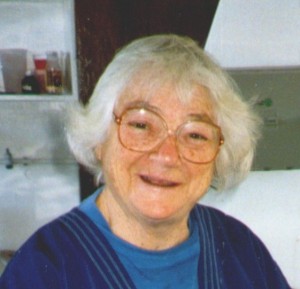
Miriam Rice 1918-2010
I often wonder what our fiberarts world might have been, (no doubt – a bit more drab, more than a tad duller) without out aquaintance with Miriam C. Rice. As natural dyers,we all have explored the enticingly colorful world of cochineal, madder, indigo and logwood, waded in the fields of goldenrod or snipped Scotch broom or rabbitbrush, soaked lichens in ammonia, black walnuts in iron water~ they all tempted and conquered and almost quenched our quest for color with a capital “C”… and then along came Miriam with an intriguing invitation to try MUSHROOMS for color, and we were hooked,caught in a wonderful new web of unknown possibilities for dyeing fibers of all sorts-from wool, silk, mohair and all of the protein fibers, to cellulose fibers, from soy-silk to bamboo.
I made Miriam’s acquaintance back in 1973, when she only needed “a few” mushroom drawings for her first book “Let’s Try Mushrooms for Color”. But as I came onto the set not only as an illustrator, but with many years of experience using natural dyes on my handspun wool, I was doubly hooked – not only with the fascination of trying to draw recognizable pictures of fungi, but with the challenge, the adventure and excitement of just trying to keep up with this remarkable woman, 20 years my senior. To become her “documentarian”, mushroom for mushroom, I tried to draw every fungi she used, and to duplicate her dye experiments, mushroom after mushroom until several mushroom dye books later I didn’t think there could be possibly anything more to be wrung out of the world of fungi….. UNTIL Miriam decided to recycle her mushroom dye detritus into PAPER and then another whole new art form was born (that needed to be illustrated), and so polypores became my drawing objects of choice for a few years….
Miriam was not satisfied with just “doing”. No, she had a natural gift to enthusiastically share, to teach, to inspire, to lead, and even after she had found a complete, ever expanding color wheel of colorfast and lightfast mushroom hues, (using only alum and iron mordants) she was not content to rest on her laurels of being the first person in the world to write a book in 1974 on the subject of mushroom dyes. She then went on to explore the possibilities of using fungal pigments for watercolors, and finally in concocting “crayons” (Myco-Stix™) for her colorful polypore papers.
Miriam’s research inspired the formation of International Fibre & Fungi Symposia in which fiber artists around the world convene every two years, in a different country, from Finland to Australia, to share, to teach, and to inspire exploration of the many possibilities in the combination of fiber arts and fungi. All those years of discovery culminated in the publication of her final book, “Mushrooms for Dyes, Paper, Pigments and Myco-Stix™” in Dec. of 2007 and the 13th International Fungi & Fibre Symposium met in Mendocino, CA in January 2008 celebrating Miriam’s 90th birthday. Though Miriam passed away on August 30th, 2010 just a week before the 14th Symposium in Sweden… she was hovering there with us in spirit over the dyepots!
Miriam was instrumental in the formation of the International Mushroom Dye Institute, (“IMDI”) in 1980, which will continue to carry on her legacy of education and exploration of the endless world of fungal possibilities for fiber arts. But there is no question that we will sorely miss her enthusiasm, tireless energy and generous inspiration to us all as we try to carry through her quest to find safe alternatives and hopefully sustainable new sources of natural dyes using fungi.
(More about the history, art, and continuing legacy of Miriam C. Rice and the mushroom dyes may be seen on the IMDI website, www.mushroomsforcolor.com ).
For more about mushrooms, click here.